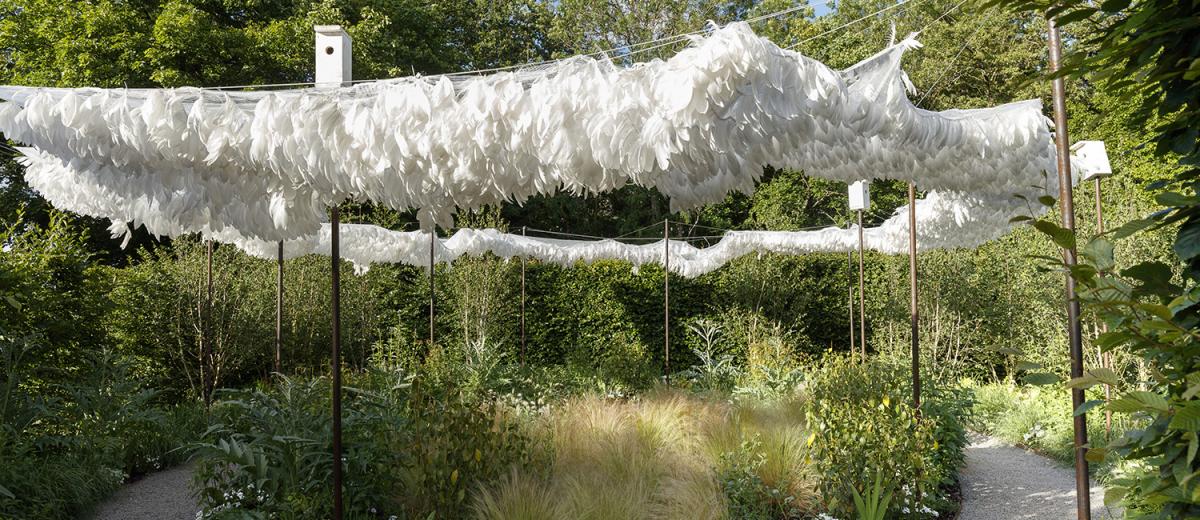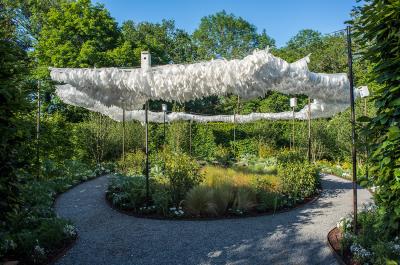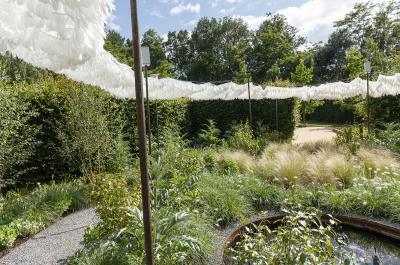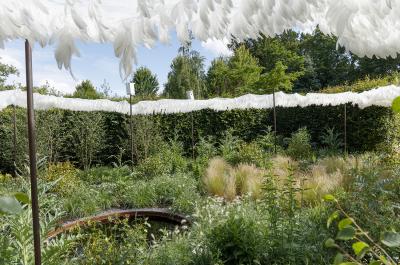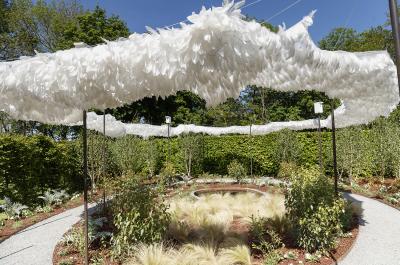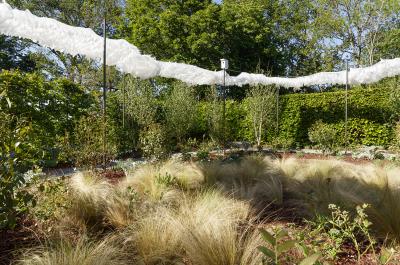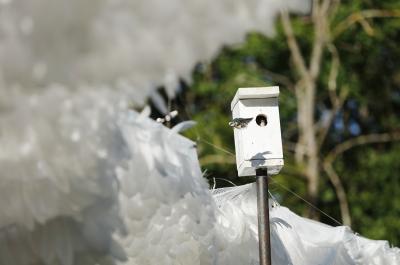If nature is complex, extraordinarily beautiful and a source of life, then paradise is simply a representation of it. Raised to a state of higher consciousness, this sensory experience illustrates the dialectic between the human and the wild.
This garden invites us to restore our relationship with beauty and nature. What could be more wonderful to achieve this than a cloud of feathers above our heads? Feathers are thermal insulators, filter UV rays, are watertight and enable flight, among other things. They have even revealed climate change through the carbon in their structure.
Beneath this white canopy, a circular pond accommodates two black swans. The garden is overrun with plants, blueberries, viburnums and artichokes which provide food for the birds, these ancestors of the gardens of paradise. Among the various species of birches, ferns and grasses which abound, an olive harvest net, worn out scaffolding and pieces of asphalt have been recycled so that life and beauty are endlessly reborn.
“All the beauty is in the feathers. I almost think a feather is the masterpiece of nature.” Alfred Russell Wallace
DESIGNERS
wHY -Mark THOMANN, landscape architect, and Naeem SHAHRESTANI, landscape designer-
Install team: Mark THOMANN, Naeem SHAHRESTANI, Quintus KROPHOLLER, Nikki SPYL
USA

wHY is an interdisciplinary design practice dedicated to servicing the arts, communities, culture and the environment. Structured as an ecology of ideas, we are a team of thinkers, architects, landscape designers & artists founded by Kulapat Yantrasast. wHY’s imaginative landscape & urban design studio, led by Mark Thomann, collaborates with clients and designers worldwide to cultivate open spaces that respond to contemporary ideas of beauty and our ecological future. Recent projects include winning proposals to reshape Edinburgh’s iconic Ross Pavilion Princes Street Gardens; Rees Ridge, a new waterfront park in Toronto; the renovation of the Rockefeller Wing at the Met in New York City and the expansion of the Asian Art Museum in San Francisco.
Mark Thomann joined wHY in 2014. A landscape architect and professor, he leads the wHY Landscape studio, working closely with wHY’s studios and collaborating with international architecture and urban design firms. His goal is to connect people and lifestyles to a vision of healthy and resilient cities and environments through the seamless integration of building, landscape and urban environments. The workshop enables art, function, nature and structure to beautifully coexist. Prior to joining wHY, he was a partner and landscape design director with Balmori Associates and landscape director with Work Architecture Company. His ability to lead conceptual design, development and management is evidenced in numerous international award winning projects and strategic plans, including the Campa de los Ingleses Park adjacent to the Guggenheim Museum in Bilbao (Spain); the master plan and vision for Public Administration Town, a new administrative city of Sejong (Korea); the Gabon Conference Centre and gardens (Gabon) with Work Architecture Company; as well as the winning Rebuild By Design competition project Resist, Delay, Store, Discharge with OMA for a comprehensive strategy for a resilient and sustainable Hoboken (USA). His works also reveals the collaborative potential of landscape, ecology and art in Skid Rows, Queens Museum Artist Gardens, 2005 with Brian Tolle; the construction and interpretation of Robert Smithson’s Floating Island, 2005 for Minetta Brook and the Whitney Museum; and Skylanding a sculpture and public art project with Yoko Ono in Chicago’s historic Jackson Park and the Art Institute of Chicago.
He joined the landscape architecture faculty at University of Pennsylvania School of Design in 2010 and Columbia University in 2012 teaching design studios that explore our ecological future and has been a studio critic, guest reviewer and lecturer at the University of Pennsylvania, Yale University, University of Toronto, Cornell University, Columbia University, Princeton University, the ASLA Awards, and Mildred’s Lane. He has participated as an invited juror for several international competitions abroad and in China. He is the author, with Diana Balmori, of Master Plan for the Sejong Public Administration Town; Topos; 60, 2007 and his work is featured in numerous publications and books, including, A Landscape Manifesto, Drawing and Reinventing Landscape, by Diana Balmori , Forum and Institute for Urban Design publication, Next New York, which highlights forty proposals imagining rebuilt infrastructure, reformed government, and an animated public realm for New York City and Transects: 100 Years of Landscape Architecture and Regional Planning at the School of Design of the University of Pennsylvania.
Naeem Shahrestani joined wHY in 2018 after completing his Masters Degree in Landscape Architecture, City and Regional Planning at the University of Pennsylvania. He is an integral aspect of our core team, working hand-in-hand with the landscape team on all phases of design projects. His conceptual thinking, research, 3D modelling, rendering and drafting skills complement wHY’s design process. At Penn Design, he was actively involved in research projects and publications, working with Professor Richard Weller on the Landscape Architecture Department publication LA+ Journal. His research has focused on the urbanization of African cities and the adaptation of urban centres to climate change and sea level rise.
